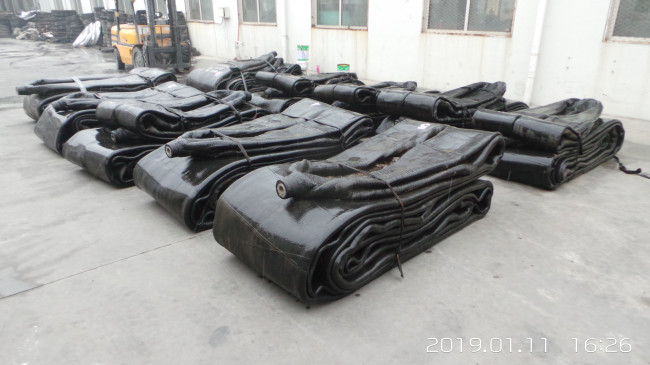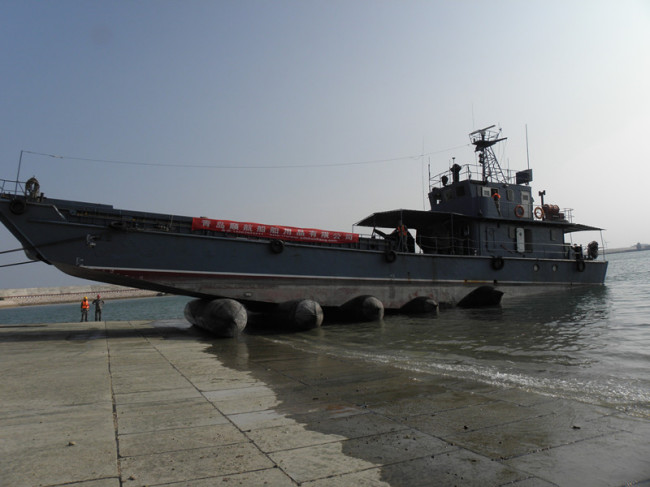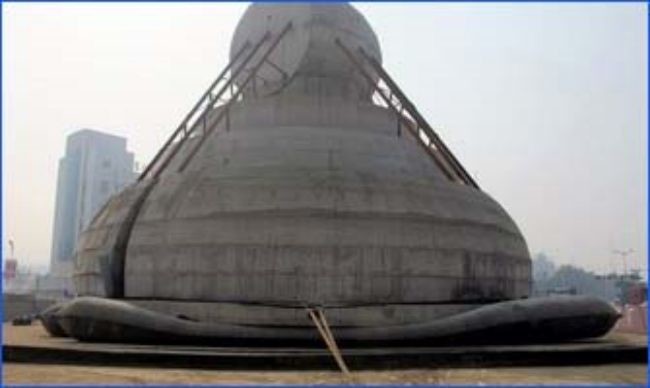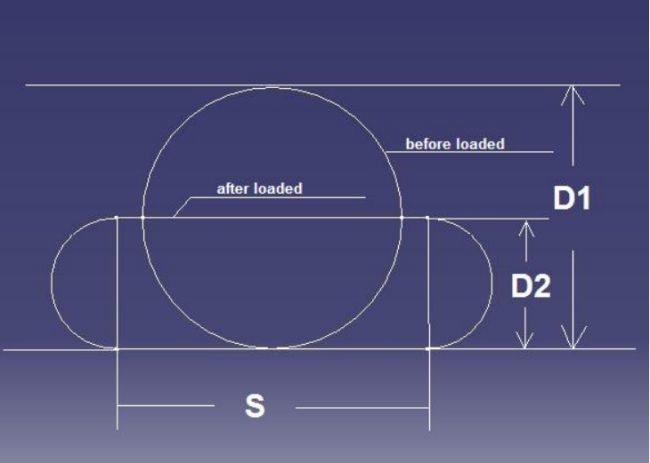QINGDAO SHUNHANG MARINE SUPPLIERS CO., LTD. |
|
Verified Suppliers
|
|
Industrial Using Customized Durable Rubber Heavy Lifting Airbags
Product Introduction:
6000 years ago, our ancestor begin to use log-rolling method to lift and move weights, which is still widely used in daily production and actual life nowadays. Marine rubber airbag is designed with soft rubber to lift and carry weights, based on log-rolling method.
Marine rubber airbag is an innovative product of Chinese own proprietary intellectual property rights. It has wide application like ship launching & upgrading, caisson lifting & moving, heavy weights lifting, underwater-engineering buoyancy aid. The marine rubber airbag is not limited to space and heavy machinery, which could efficiently shorten the construction period and save lots of funds.
Heavy lifting airbag is updated based on the ship launching airbags. This update makes heavy lifting airbags are more suitable for heavy lifting and moving work. Heavy lifting airbags have a different structure from the ship launching airbags. It can roll steadily when taking the load.
The heavy lifting airbag is one kind of the toughest inflatable lifting airbag. It can be used for heavy lifting and moving of huge heavy structures, caisson, buildings, etc.
Heavy lifting and transportation relying on heavy lifting airbags are cost-effective and flexible. Heavy lifting airbags will provide you with a unique capability of land transport very large vessels, heavy loads, or heavy construction .
The deflated heavy lifting airbag is very flat and can be placed under a grounded or stranded vessel that is hard aground. As little as 12 inches will provide very quick placement of lifting airbags under the hull.
The structure of Heavy Lifting Airbag:

Structure of Marine Airbag
1. Terminal iron
2. Cone airbag body
3. Cylindrical airbag body
D: Diameter of airbag
L: Valid length of airbag
Loa: Total length of airba
Specifications:
| Some common sizes of our heavy lifting airbags, customized sizes are also available | |||
| Diameter(m) | Effective Length(m) | Layer | Pressure(MPa) |
| 1.0 | 10 | 5~6 | 0.07~0.10 |
| 1.0 | 12 | 5~6 | 0.07~0.10 |
| 1.0 | 15 | 5~6 | 0.07~0.10 |
| 1.2 | 10 | 5~6 | 0.08~0.12 |
| 1.2 | 12 | 5~6 | 0.08~0.12 |
| 1.2 | 15 | 5~6 | 0.08~0.12 |
| 1.5 | 12 | 5~8 | 0.08~0.16 |
| 1.5 | 15 | 5~8 | 0.08~0.16 |
| 1.5 | 18 | 5~8 | 0.08~0.16 |
| 1.5 | 20 | 4~8 | 0.08~0.16 |
| 1.5 | 24 | 5~8 | 0.08~0.16 |
| 1.8 | 12 | 5~8 | 0.08~0.15 |
| 1.8 | 15 | 5~8 | 0.08~0.15 |
| 1.8 | 18 | 5~8 | 0.08~0.15 |
| 1.8 | 20 | 5~8 | 0.08~0.15 |
| 1.8 | 24 | 5~8 | 0.08~0.15 |
| 2.0 | 18 | 6~10 | 0.08~0.18 |
| 2.0 | 20 | 6~10 | 0.08~0.18 |
| 2.0 | 24 | 6~10 | 0.08~0.18 |
| 2.5 | 18 | 7~10 | 0.07~0.13 |
| 2.5 | 20 | 7~10 | 0.07~0.13 |
| 2.5 | 24 | 7~10 | 0.07~0.13 |


Application:
Boat Lifting / Launching / Docking



Industrial foundation lifting and moving

Lifting Capacity

The bearing capacity of heavy lifting airbags were calculated based on the working pressure, contact area. Herein, working pressure was got upon the burst pressure and safety working factor.
Because of the flexibility of rubber airbag, the contact area will be effected by some terms. It inludes carried shipcondition, the different position from gravity center during the process of ship launching and landing. So the bvearing capacity of rubber airbags will vary as well as the contact area.
The approximate bearing capacity can be calculate as follows:
F=PS S=π x (D1-D2)/2
Where:
F is the bearing capacity
P is the working pressure
S is the contact area
P is the percentage of deformation (%);
D1 is the original diamater of the airbag (m);
D2 is the height of the compressed airbag (m)
Attention During Application
1. Working pressure must be controlled strictly, it is not allowed
to exceed the working pressure.
2. No sharp and protruding hard object on the contacting surface of
the airbags, to avoid the puncture on the skin of airbags.
3. Avoid the distortion along the length of airbag.
4. Empty inflating test must be performed if the airbags were not
used for a long time or after reparation. The pressure should be as
same as the testing pressure of our company. Inspectors must be at
least 3 meters away from the airbags. For repaired airbag which was
damaged in large scale, its working pressure should be lowered
reasonably. Besides, annual check should be conducted on airbags
which are used frequently.
5. Don’t drag the airbags on the ground.
Instruction of Airbag Repair
If the airbag is damaged, it can be repaired as long as the rubber doesn’t age seriously(with no crack and stickiness on the surface). And the cords fabric is not loose and rotten. Repair can be made by hot vulcanization or auto-vulcanization. The tolls and repair materials utilized in the former are quite simple. We recommend hot vulcanization, the steps are as below,
1. Wash the airbags to make sure it is clean both inside
and outside and without mud & sand,
oil stain and water logging. Then dry the surface. Note: the
immersion time while washing can’t more than 10 minutes.
2. Mark the repair symbol visibly. Mark the repair area
and the mark area is allowed to exceed 15mm, don’t miss the
concealed damage.
3. Prepare the backing
The material of backing is the same as the airbag and the
arrangement angle of the cord fabric is consistent with the airbag.
The first layer of the backing is a vertical line. Length=(length
of the flaw+50mm)X2
The second layer of the backing is oblique line whose angle is the
same as the airbag. It is 20mm larger than the periphery of the
first layer.
The third layer of the backing is also oblique line whose angle is
opposite to and crosses with the second layer. It is 20mm large
than the periphery of the second layer.
The fourth, fifth and sixth layer may be deduced by analog.
The fillet transition with the radius of 40mm-50mm is required for
the backing periphery of every layer.
If the wound is a nail hole within 100mm or strip wound in 50-70mm,
cross backing shall be prepared. Nylon cross backing is made by
bluing two layers of coated Nylon with the crossing of 90°. Its
size is 200mmX200mm and others are the same as the backing.
4. Filing the wound
File the wound with steel files or flexible shaft filing machine.
The file pattern on the surface should be delicate and even as well
as without any rubber scrap, particle. Filing surface depth is
about 0.5-1mm. The periphery is 20mm larger than the backing.
Breaking and loose is not allowed for filed cord fabric. After
filing, blow always the rubber scrap by brush and compressed air.
5. Brush glue and dry
The whole process must be kept clean. Brush thin glue for the first
time (glue: gasoline=1:8).There should be no sediment and caking,
should be evenly. Forcibly gluing should be performed so that the
glue can penetrate into the cord fabric layer in the file slot. The
gluing should be uniform and obvious scaffold erecting is not
allowed.
6. Viscose
Firstly, brush a layer of base glue with the thickness of 1±0.2mm
on the periphery of the wound. Cool down to not gluing hands, paste
and press and the glue should not be too tight in case glue failure
happens after the new glue contract, then paste the backing. The
center of the backing should be targeted at the wound center. The
angle of the backing should be in consistent with the airbag line
layer. For wound larger than 1M, a layer of coated Nylon fabric
should be pasted to the wound, 25mm lager than the wound. Then
paste the backing. In the end, one sealing rubber (thickness of
0.8-1mm,wideth in 20mm) should be pasted to the cover the joint of
backing edge and body of airbag.
7. Vulcanization
For normal shipbuilding yard, the following simple method can be
adopted: set up a frame, ( as shown in the figure) and provide
plate, sand bag(fill the inner tube of the abandoned automobile
with sand), jack and heated plate(pig iron or steel plate in
Dia300mm ,thickness 25mm). The vulcanized airbag to be repaired
should be targeted to the center in accordance with the position
shown in the figure. First vulcanize the hole and then the wound.
If the large wound to be vulcanized exceeds the effective length of
the vulcanization, the center should be vulcanized firstly then
both sides. The heated plates should overlap 15mm with the previous
position in re-vulcanization. The vulcanization shall be finished
within 40-50 minutes when the temperature rises to 135±5℃ and
pressure is 0.8-0.12MPa.
8. Check whether the repair is bound tightly or not, Flaw such as void, delaminating or sponge and so on are not allowed. As to new glue in heating area, aging, crack, under vulcanization and over vulcanization is not allowed. Inflating test shall be conducted if the repair is qualified.
